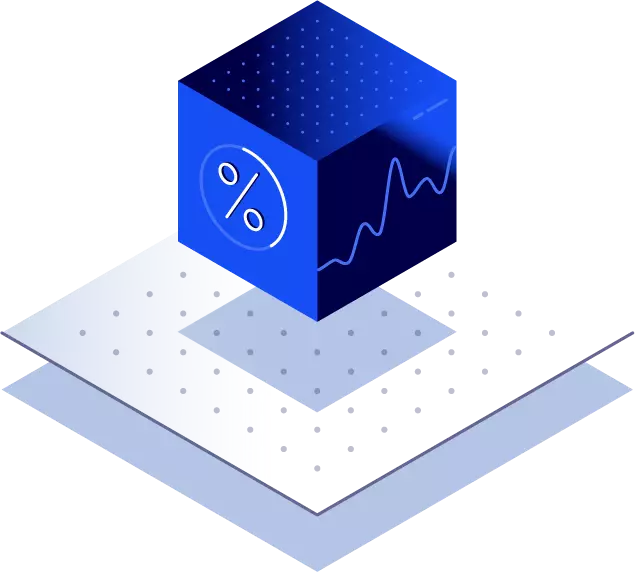Liquidity Flywheel Drives Binance to 300 Million Users

TUSD Depegs Amidst Heavy Borrowing

-
TUSD trading at a premium after a spike in market depth and Defi lending.
-
BTC-USD trading shifts towards weekdays.
-
PEPE trade volume surges 10x after OKX listing.
-
Derivative markets are less concentrated than spot.
Trend of the Week
TUSD hits $1.2 on Binance amidst heavy borrowing on DeFi lending protocols.

TUSD depegged on a number of exchanges yesterday, hitting a high of $1.20 relative to USDT on Binance. Binance has recently been promoting TUSD, making BTC-TUSD the only zero-fee pair on the exchange. This quickly made Binance BTC-TUSD one of the highest-volume pairs in all of crypto despite TUSD being relatively unknown amongst stablecoins. Additionally, TUSD liquidity has not kept pace with its volumes, making a depegging like this more likely.
Interestingly, as TUSD began to depeg, a number of users on both Aave and Compound began to borrow large amounts of the token. Most of these transactions appear to be organic rather than bot-driven. The most common strategy was borrowing TUSD and swapping for USDC, effectively shorting TUSD from its elevated price. However, neither Aave nor Compound have a large supply of TUSD, which meant that borrowing rates quickly surged, hitting over 100% APR on both protocols.
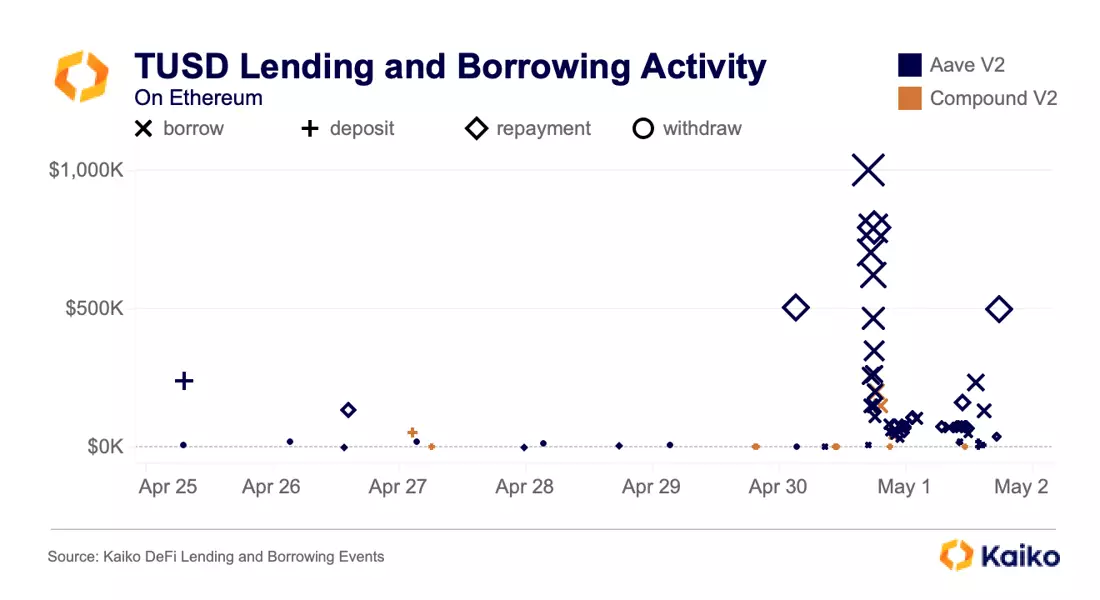
As TUSD began trading at a premium, Justin Sun was spotted sending over $50mn worth of TUSD to Binance. This prompted onlookers to question if Sun was trying to farm the SUI liquidity pools on Binance, which requires users to stake TUSD or BNB. CZ then tweeted that Binance would take action against any farming by Sun. Sun responded, admitting someone on his team was using a portion of the funds to farm, however he went on to claim that most of the funds were to be used for market making TUSD on the exchange.
Looking at market depth for the TUSD-USDT pair on Binance, someone has been adding liquidity in massive size: the pair is now the most liquid pair on Binance after a huge $200mn injection of orderbook liquidity at the 1% level.
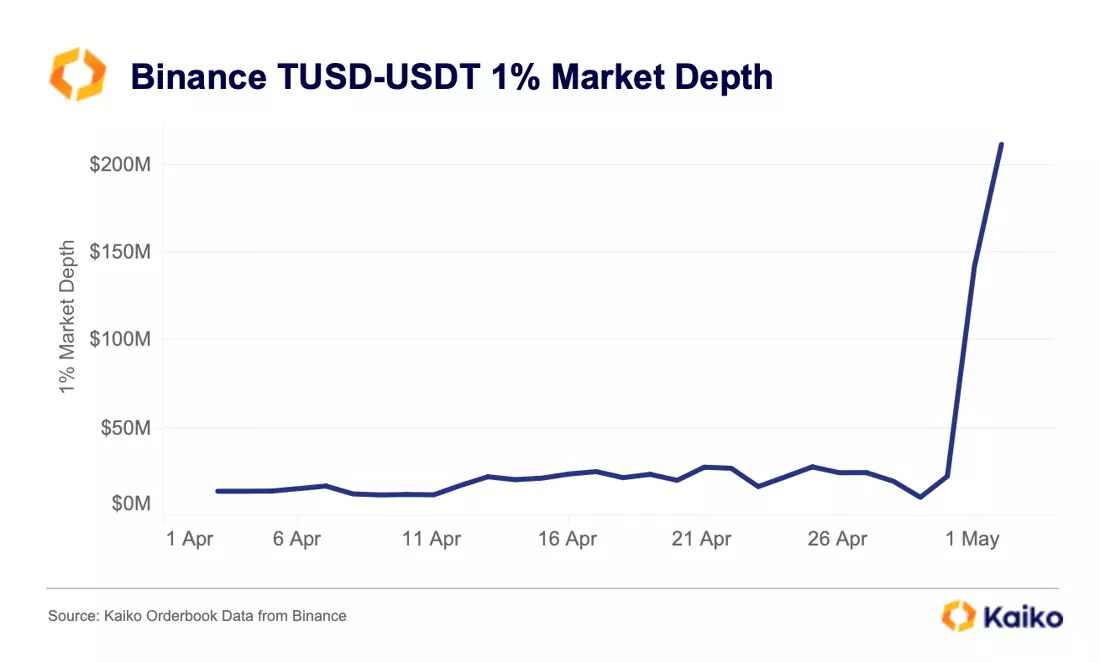
With increased depth and surging demand thanks to Binance’s SUI launchpad, TUSD continues to force its way into the stablecoin conversation.
Never miss an analysis.
Subscribe to our free weekly Data Debrief email, or learn more about our premium research subscriptions here.
Price
AI tokens outperform BTC YTD.
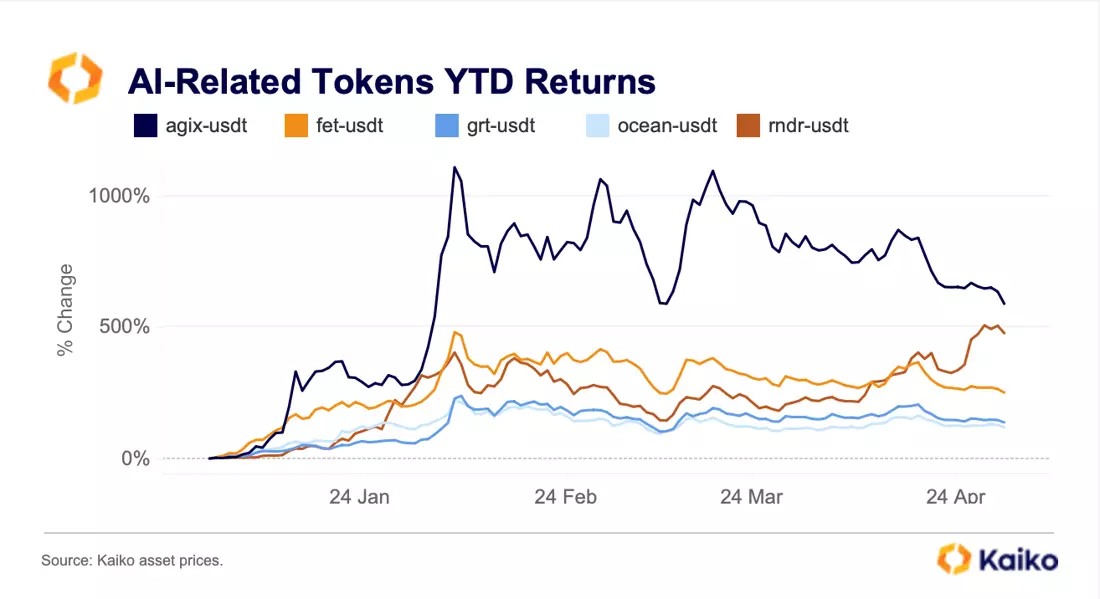
AI-related tokens have experienced remarkable growth this year, even amidst the ongoing U.S. banking turmoil. Decentralized machine learning platform SingularityNet (AGIX) has been the top performer, soaring 592% since the beginning of the year. Render’s RNDR token, which facilitates cloud-based 3D graphics rendering, has climbed 480%. Ocean Protocol (OCEAN), concentrating on secure data sharing and collaboration, posted the smallest gain at 120%.
Although the launch of ChatGPT in late November 2022 contributed to the rally, most of these projects have existed since 2017. Trading volumes have increased as well, with the combined daily volume for GRT, AGIX, FET, RNDR, and OCEAN surpassing $1 billion in early February, a two-year high. Despite a decline in March, trade volume remains above the long-term average.
PEPE centralized exchange volume surges 10x on OKX listing.
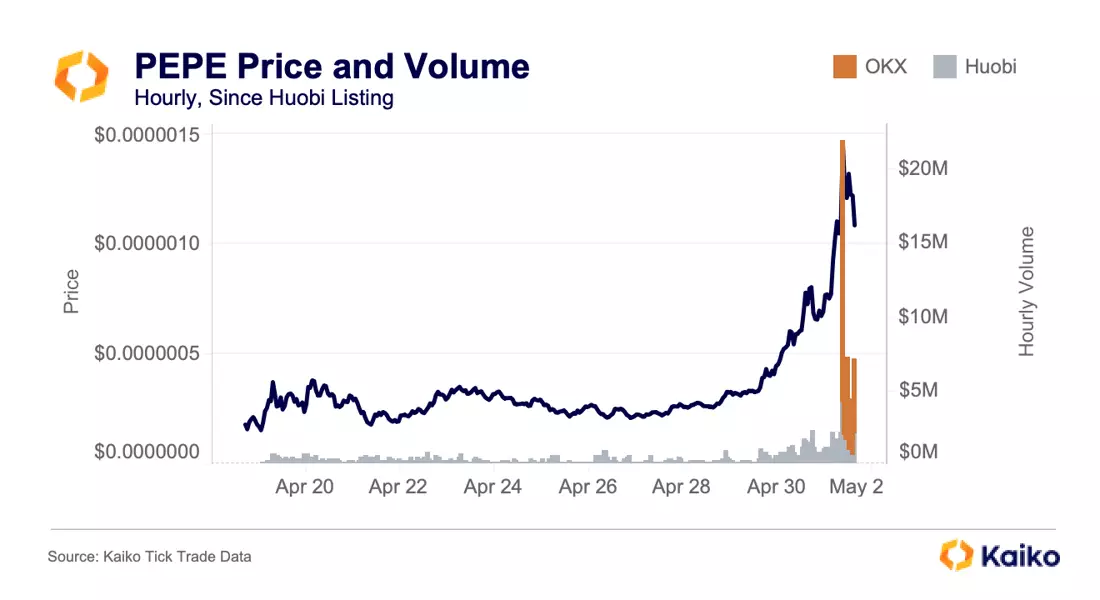
PEPE, the latest memecoin, was listed on OKX on May 1, doing nearly $20mn of volume in its first hour of trading. Huobi, the largest exchange offering the token before OKX’s listing, did just $4mn in volume during this time period. PEPE was first listed on Uniswap V2 on April 14, and wasn’t listed on a major exchange until April 18, when Huobi listed the token. However, even as volume has surged on CEXs thanks to OKX, OKX is still only facilitating about half as much volume as Uniswap. PEPE’s market cap briefly breached $500mn, still 25 times smaller than DOGE’s.
Liquidity
BTC-USD trade volume shifts to weekdays after SEN closure.
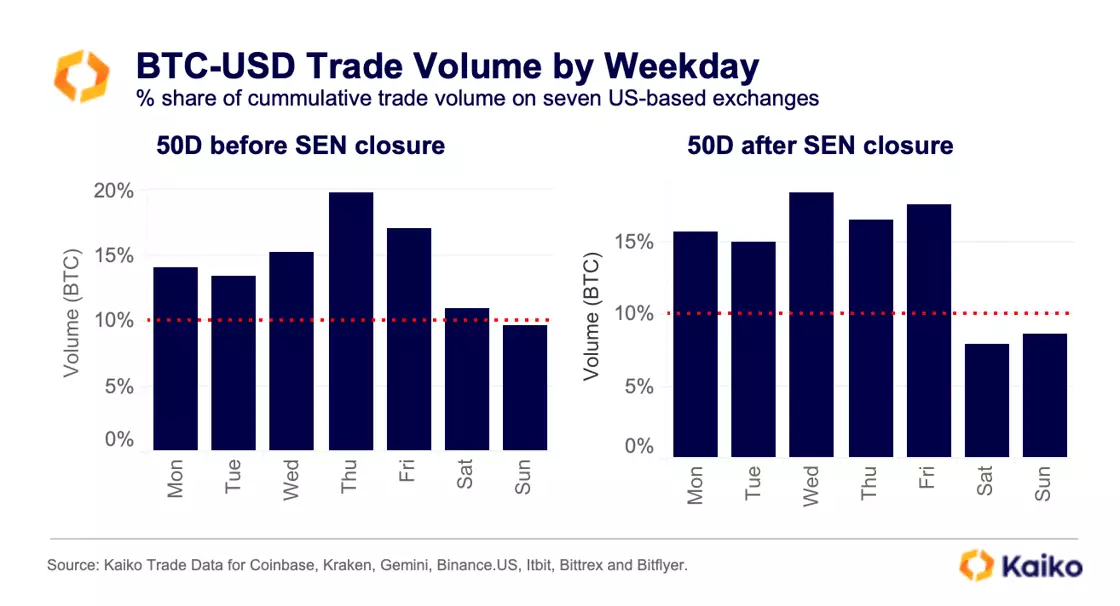
The closures of Silvergate and Signature’s real-time payment networks, SEN and Signet, have noticeably impacted weekend BTC-USD trading patterns. The share of weekend BTC-USD trades on seven U.S.-based exchanges has dropped from 21% to 17% in the 50 days following Silvergate’s closure on March 3. Average daily weekend trade volume has decreased by 10%, while average daily weekday trade volume has risen by 16%. This shift suggests that trading activity has moved to weekdays due to increased weekend trading challenges.
The long-term continuation of this trend remains uncertain. Although other banks will likely fill the void left by SEN and Signet, they may impose higher costs due to ongoing regulatory uncertainty.
U.S.-regulated venues capture market share in 2023.
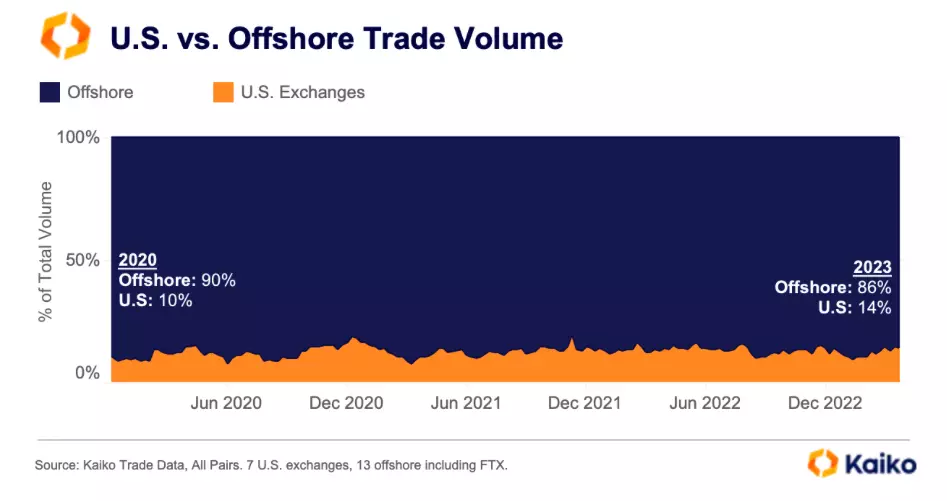
Despite ongoing regulatory challenges, U.S. exchange market share has held firm (and actually increased slightly) since the start of 2020. In January 2020, U.S.-regulated exchanges accounted for 10% of spot volume. This number has fluctuated since then, with a consistent downtrend from December 2020 until May 2021, a relatively flat trend from summer 2021 until December 2022, then a quick decline and rebound.
When FTX collapsed, we theorized that institutions would opt for the perceived safety of U.S.-regulated exchanges. In the short term, this has seemingly been reflected in the data, though regulatory environments could be influential. The EU’s recent passage of MiCA stands in stark contrast to an unclear outlook in the U.S., and Coinbase CEO Brian Armstrong has floated the idea of moving the exchange out of the U.S.
BTC-USD average trade size remains below 2021 highs.
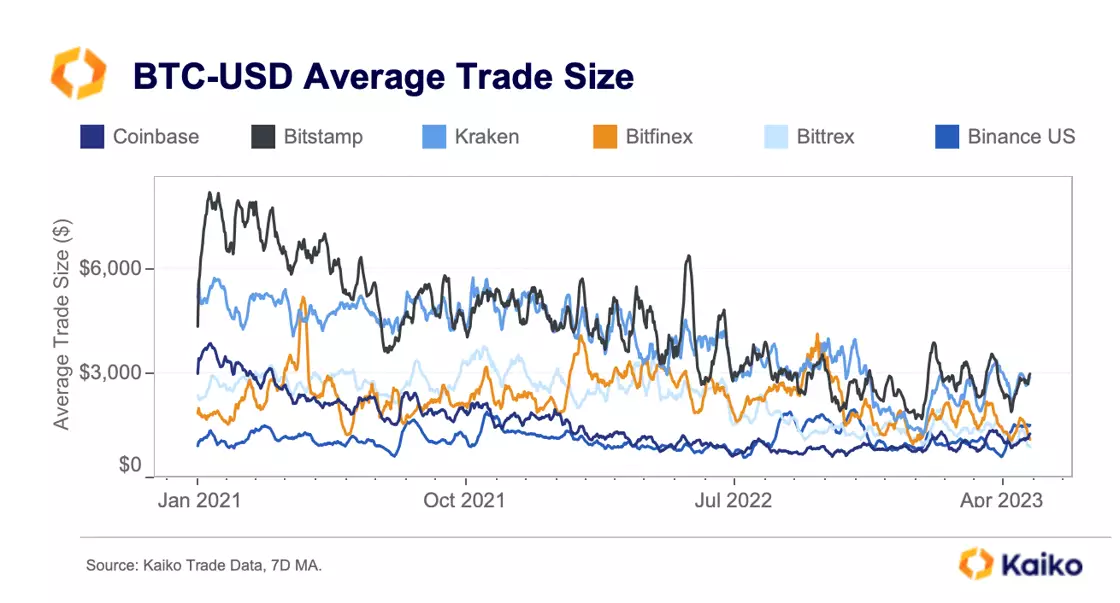
Despite the 70% YTD rally in BTC-USD prices, average trade size has only slightly increased and remains well below early 2021 highs. This trend suggests a decline in trader participation and relatively low market activity. Notably, while the average trade size in USD terms has returned to pre-FTX levels on most platforms, it remains significantly lower in BTC terms. This discrepancy implies the increase in average trade size may result from a price effect rather than heightened market activity. In the past two years, average trade size has dropped from $5.7k to $2.8k on Kraken, from $3k to $1.2k on Coinbase, and from $3.2k to $865 on Bittrex.
Implied Volatility
Surfaces Now Live
Kaiko’s IV surface data follows the launch of IV Smiles last year. The new addition includes space and time interpolation, enabling even more precise and complete analysis for clients. The product now has the ability to provide accurate volatility for a range of expiry dates and strike prices, even those not listed.
-
introduction of multi-source aggregation
-
more robust and manipulation-resistant, using a trusted transparent methodology
-
advanced algorithms and new interpolation framework
-
stay ahead of market trends & make informed trading decisions
Derivatives
Derivatives markets are less centralized than spot.
As trade volumes remain down compared to last year, many exchanges are exploring various strategies to boost revenue streams. Derivative exchanges like Bybit, BitMEX, and recently Deribit have launched spot trading platforms, while U.S.-regulated spot exchanges such as Coinbase and Gemini launch offshore derivative trading platforms. This consolidation highlights the fragmentation in the crypto market, with spot and derivative markets experiencing different concentration levels.
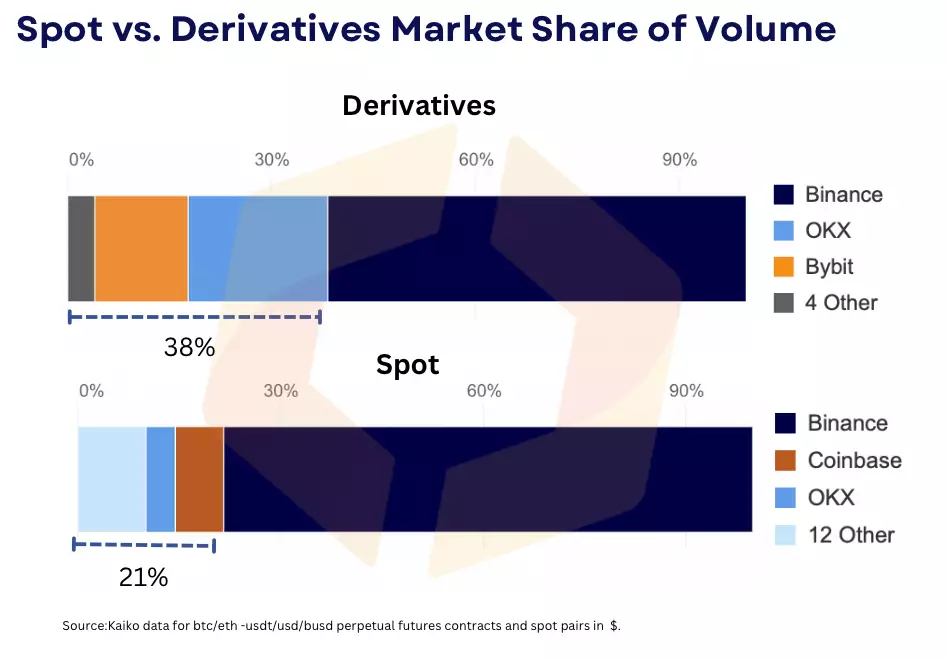
Although Binance’s BTC and ETH perpetual futures market share has increased by 10% since FTX’s collapse, derivative markets remain more fragmented than spot markets. Binance dominates around 80% of spot trading but only 60% of derivative markets, with Bybit and OKX comprising over 30% of the market. In contrast, the second and third largest spot venues, Coinbase and OKX, account for only about 10% of trading volume.
Entering the highly concentrated spot market could prove challenging for smaller exchanges competing for customers and liquidity.
BitMEX, an early crypto derivatives exchange, launched a spot trading platform in May 2022 to attract new customers and create synergies between spot and derivative trading. However, its derivative volume share plummeted after Binance entered the market in 2020.
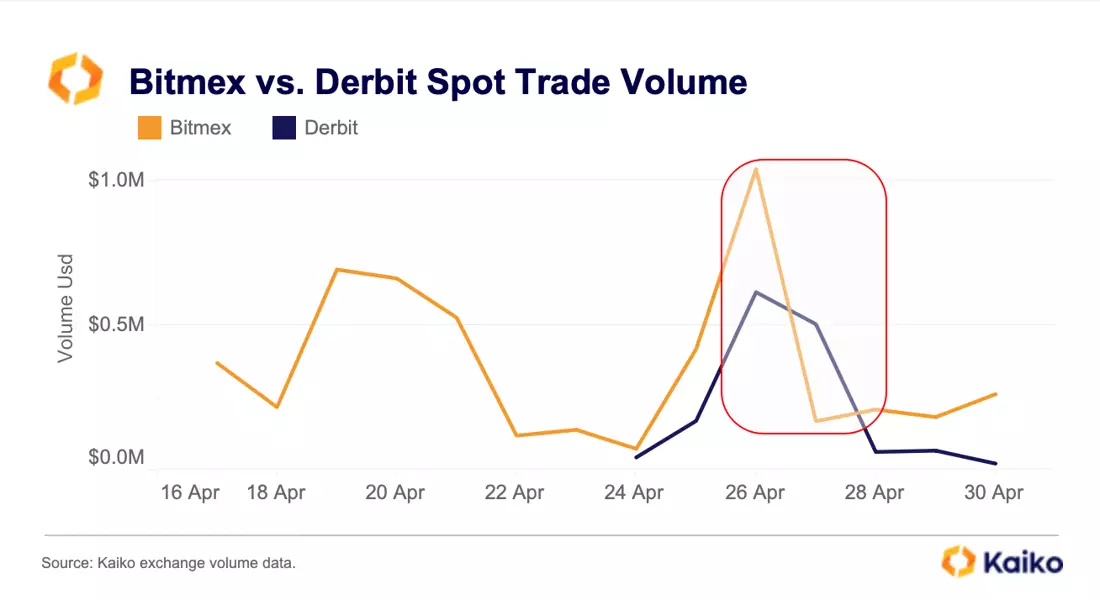
Despite offering zero-fee trading promotions, Bitmex’s daily spot volume has declined from an average of $3.3mn in 2022 to just $600k in 2023. While Deribit’s spot market has had a strong start, briefly surpassing Bitmex in daily trade volume shortly after its launch, volumes have fallen sharply to just $21k after the initial surge.
Macro
U.S. regional bank crisis deepens with second largest bank failure in history.
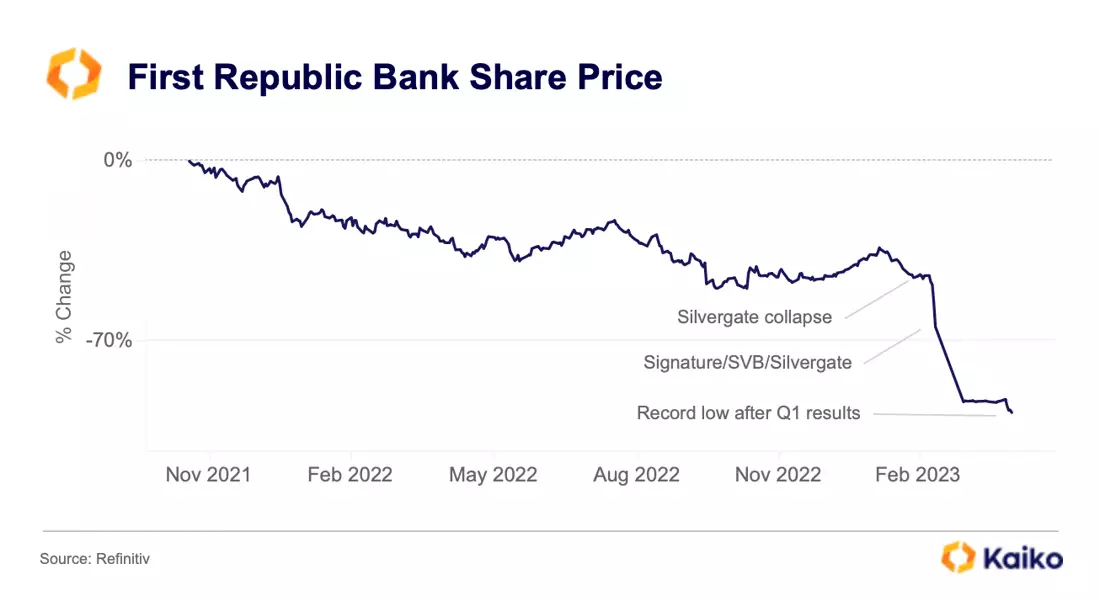
First Republic Bank (FRC), the 14th largest U.S. lender, was taken over by regulators and auctioned off over the weekend after its share prices plummeted 73% last week. FRC focuses on high-net-worth customers and holds a significant amount of long-term mortgages that have lost value due to the Fed’s aggressive rate hikes since March 2022, as well as higher than average levels of uninsured deposits. Investors withdrew over $100mn in deposits in Q1, concerned that the bank would face losses if forced to sell assets to raise cash.
This marks the fourth U.S. bank failure in less than two months, shaking confidence in regional banks and, according to some, bolstering Bitcoin’s narrative. FRC has underperformed both BTC and the S&P 500 since early March. BTC rose 7% last week despite strong intraday volatility and is up 30% since Silvergate’s collapse on March 8. The S&P 500 also closed the week in the green, driven by stronger-than-expected big tech earnings, and is up 4.4% since early March. BTC’s 60-day correlation with gold reached its highest level in months, currently surpassing its correlation with the S&P 500 for the first time since May 2021.
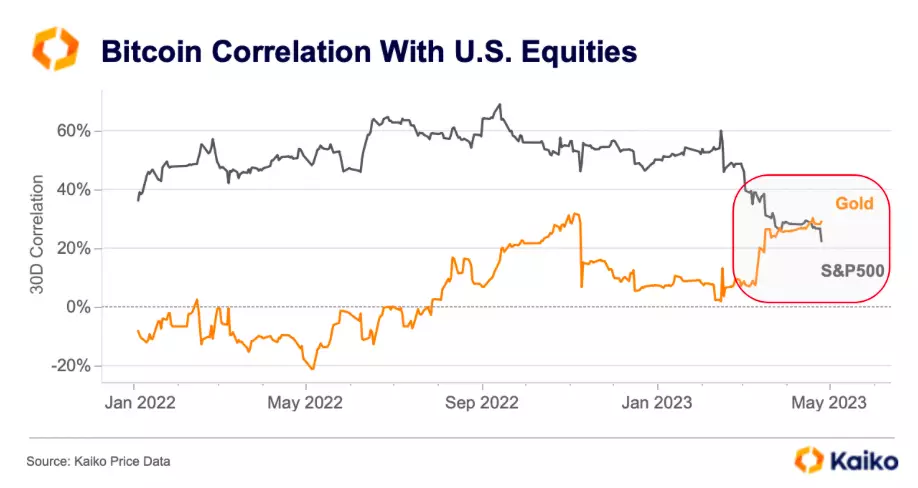
Although BTC’s rising correlation with gold and increasing dominance suggest that its appeal as a safe haven may be improving, its outperformance is primarily driven by an improving liquidity outlook. Banks are tightening lending standards due to deposit churn, which in turn slows the economy and reduces the need for further rate hikes. Despite persistent inflation, the Fed is now largely expected to hike by 25 bps one last time at its meeting this week before pausing for the rest of the year.

Data Used in this Analysis
Derivatives Metrics
![]()
Metrics and analytics products tailored to the cryptocurrency derivatives market.
Liquidity Metrics
![]()
The most granular order book data in the industry optimized for quantitative analyis.
Trade Volume
![]()
Centralized exchange data sourced from the most liquid venues, covering all traded instruments.
More From Kaiko Research
![]()
Derivatives
22/12/2025 Data Debrief
Crypto in 2026, What Breaks, What Scales, What ConsolidatesCrypto markets enter 2026 in a markedly different position than in prior cycle transitions. Rather than resetting after a speculative peak, the market appears to be progressing through a phase of institutional consolidation.
Written by Thomas Probst![]()
Year in Review
01/12/2025 Data Debrief
Kaiko Research's Top 10 Charts of 2025In this report, we look back on 2025 and the key forces that shaped markets. From BTC record highs and fleeting altcoin rallies to major liquidation events and evolving regulation, we examine what shaped a seminal year for crypto.Written by Adam Morgan McCarthy![]()
Stablecoin
24/11/2025 Data Debrief
MiCA's Impact on Crypto in EuropeEurope is progressing with a conservative structured crypto framework that leans towards regulating innovation.Written by Adam Morgan McCarthy![]()
Macro
17/11/2025 Data Debrief
Navigating Fed Fears & AI Bubble BurstingGiven the current macroeconomic context, we are seeing the emergence of two major risks likely to have a decisive impact.
Written by Adam Morgan McCarthy




